by Amy Weintraub
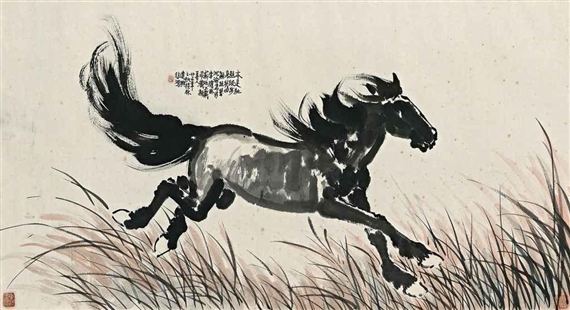
Running Horse by Xu Beihong
These are anxious times. I don’t have to tell you why. Waking up in the morning to face the headlines takes courage for us all. Some of us however are especially prone to a state of rajas, that revved up, often worried mindset that is clinically labeled anxiety.
My partner tells me that I sometimes have an intense energy around me that causes her to react. I may think that I’m speaking neutrally, but my worry or frustration (rajas) gives my words a tinge that can sound critical. Here’s the pattern: I call her on her reaction to that “innocent” statement, and she calls me on my tone of voice. We talk and we both feel better. This morning, after a break in communication and then a repair, we went on a bike ride. Her words had been harsh, and I noticed that I still felt wounded and withdrawn. When we reached the top of the mountain, she did another loop, while I did standing poses and pranayama. As I opened my arms out in front of my body in a variation of Warrior I, I used a heart-opening mantra, and asked that I be a vessel of love and ease in our partnership. When she rejoined me on the mountain top, I no longer felt that separation from her, from my own heart, and from my sense of the divine.
I tell you this story because, although I’ve been practicing and teaching yoga for over thirty years, it’s still my daily medicine. I’ve sat at the feet of yoga masters who say that at a certain point, the practices are no longer necessary. I can understand that sometimes our practices can be too much “doing” and may distract us from the simple act of being fully present. I’ve felt that now and then, and when I do, I shed a mantra or pranayama for a while. When I take it up again, it feels like a new discovery, opening a channel to a direct experience of the divine.
Anything can feel rote or boring after a while—even yoga. That’s why we need a compendium of practices to meet our shifting moods. My own innate tendency toward anxiety, and my efforts, through yoga, to stay balanced and calm and to help others do so as well, have led me to synthesize practices from several yoga traditions under the umbrella of LifeForce Yoga.
When we feel agitated, it might be fine for us to do a simple pranayama like Alternate Nostril Breathing (Nadi Shodhana), or even Left Nostril Breathing (Chandra Bhedana) to bring the body-mind into a more balanced state. However, sometimes we may feel too anxious to sit with a simple breathing practice. If that’s the case, consider meeting that anxious state with movement (Sun Salutations, Warrior poses, and other standing poses). Or you can try a staged breathing practice, Stairstep Breath (Analoma Krama), in which you inhale slowly through your nostrils in several stages until your lungs feel full, and you then let your breath out slowly through your nose. This may sound counterintuitive, but the key to finding that inner peace is what you do after meeting your agitated state.
Whether you burn off your excess rajas energy with a dynamic flow of standing asanas, with a run up a mountain, or with the Breath of Joy practice on Card 5 below, allow your eyes to soften or close. Take a moment to sense the energy in your hands—palms, fingertips, your arms, your face—left side, right side. The body is always present. The mind is a time traveler. When you bring your attention to the sensation in your palms, you are the presence you seek, a window through the anxious mood. Complete your sequence with this grounding breath: Inhale from your feet to your crown, as you say to yourself, “I am.” Exhale to your feet, as you say to yourself, “here.”
Notice that I did not suggest that you “feel the sensations in your body.” There’s a good reason why I am specific rather than global in the way I cued the mini-body scan above. For some of us who are highly anxious or have a history of trauma, it does not feel safe to be guided to “notice” or “feel” the sensations in our bodies in a general way. There’s likely a good reason we are living from the neck up. We may experience a lovely series of poses or other aspects of yoga practice, but when cued to sense into the body generally, we may have anxious thoughts like “Where?” or “What am I supposed to feel?” or worse. We may panic or freeze because our previous lived experience has shown us that being aware of our bodies isn’t safe. However, when we sense the tingling in the palms, or the feet or the face, it’s a gentle way to re-occupy our bodies.
When anxiety is present, sensing our bodies in a way that is gentle and specific after a pose, a sequence of poses or a pranayama, and then grounding our awakened energy, is the best way I know to achieve and sustain balance.
So let’s take a moment to practice two cards from the Yoga for Your Mood Card Deck. The first card will meet the revved-up state of anxiety and then ground it in the body. The second card for most of us will calm your nervous system and offer us a pathway to meditation.
Please remember that we have individual constitutions and histories, so when I say, “for most of us,” I mean that some of us may experience something entirely different. That’s absolutely okay. If you experience something other than a calmer state, it can be an avenue for self-inquiry. Self-inquiry with compassion, in my opinion, is the highest form of yoga.
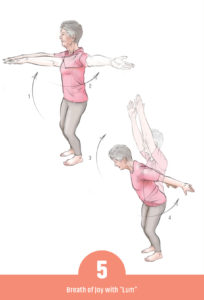
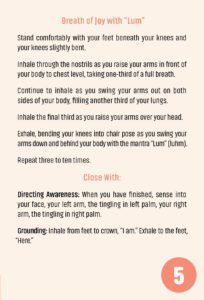
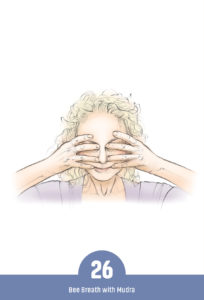
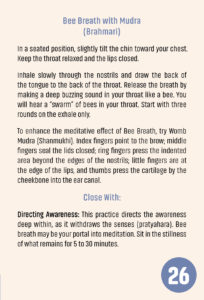
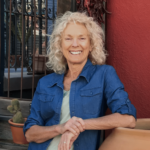 Amy Weintraub, MFA, C-IAYT, is the founder of the LifeForce Yoga® Healing Institute, an acclaimed yoga therapist, and a pioneer in the filed of yoga and mental health. Author of the best-selling Yoga for Depression and Yoga Skills for Therapists, she teaches and guides thousand of practitioners and therapists around the world. Her novel Temple Dancer was released in 2020 to excellent reviews. She thrives in Tucson, Arizona, where she mountain bikes, dancers, writes, and creates. Follow Amy on INSTAGRAM, FACEBOOK, YOUTUBE , TWITTER, GOODREADS , AMAZON
Amy Weintraub, MFA, C-IAYT, is the founder of the LifeForce Yoga® Healing Institute, an acclaimed yoga therapist, and a pioneer in the filed of yoga and mental health. Author of the best-selling Yoga for Depression and Yoga Skills for Therapists, she teaches and guides thousand of practitioners and therapists around the world. Her novel Temple Dancer was released in 2020 to excellent reviews. She thrives in Tucson, Arizona, where she mountain bikes, dancers, writes, and creates. Follow Amy on INSTAGRAM, FACEBOOK, YOUTUBE , TWITTER, GOODREADS , AMAZON
Follow Yoga for Healthy Aging on Facebook ° To order Yoga for Healthy Aging: A Guide to Lifelong Well-Being, go to Amazon, Shambhala, Indie Bound or your local bookstore.


Leave A Comment